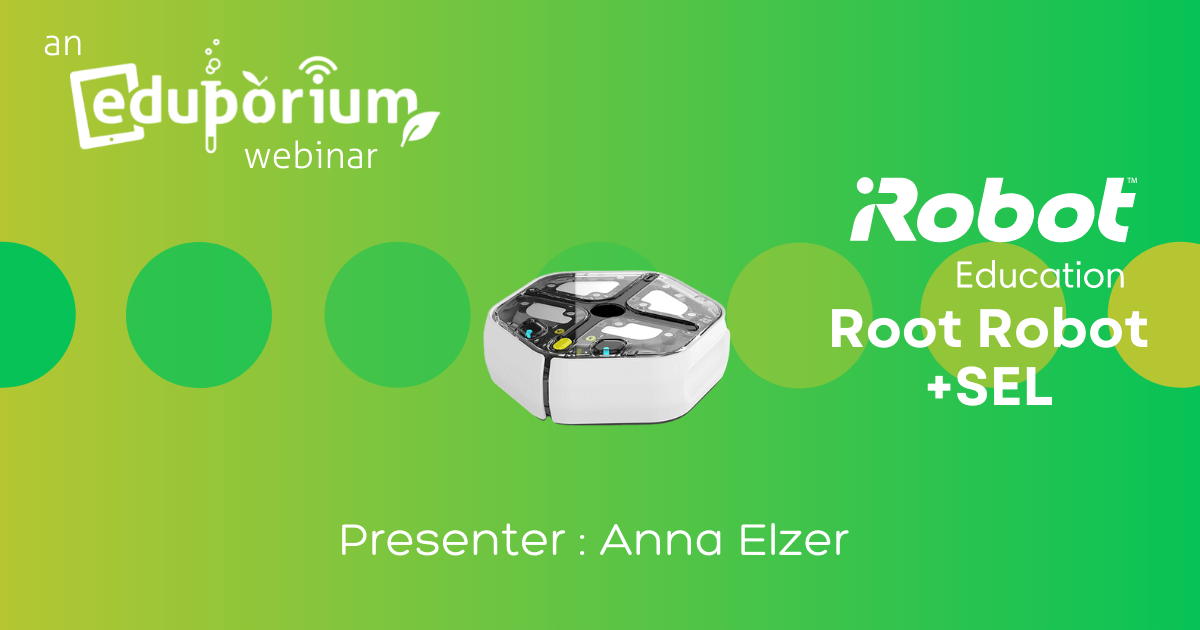For the fourth of our five back-to-school STEAM and SEL webinars, we partnered with our friends from the iRobot Education team. We hosted the broadcast this past Wednesday as we welcomed iRobot’s Anna Elzer and Daniella Bonazzoli. The pair shared the iRobot story, including how, despite being known for the world-famous Roomba robot, every member of their organization is also committed to advancing education in one way or another. With help from audience questions, they discussed the Root robots, the technology within them, creating SEL connections, and more.
They started by discussing the Root’s sensors, which are found on its top and bottom. It’s outfitted with touch sensors for whiteboard compatibility, bump sensors so it can crash into walls or other objects without damage, a cliff sensor so it never falls off a desk, and a color sensor comprised of 32 different microsensors. As for the other Root robot, the Root rt0 is slightly more consumer-friendly and often used more at home. Unlike the original Root, it’s clear, which allows students to see its internal hardware working. Its sensors are also on the bottom and allow students to do much of the same as with the Root.
Anna and Daniella then talked about the iRobot Coding platform—the digital side to programming with the Root. As you may know, this platform enables students to code in three increasingly complex environments: block, hybrid, and text. Depending on their skill sets, they can bounce between levels. This allows them to see how their code changes as well as how it affects the robot’s actions. For clarity, the hybrid level is a mixture of graphical and script coding while the text level is full Python coding and, in their words, “what the coding pros use.” From there, they talked about and showed attendees the iRobot Learning Library, which is a digital collection of resources, activities, and lessons on all subjects, including robotics, math, SEL, ELA and more.
Of course, we wanted to showcase using the Root Robot to advance SEL and these activities are the perfect example. Anna and Daniella explained how educators can create these connections using the Root and how the digital content amplifies impact. In their minds, SEL is extremely pertinent right now and should remain so moving forward. They also believe that students build many of the core SEL competencies, like self-expression, finding their identity, and building relationships, through their traditional educational experiences. Providing SEL-focused activities for teachers, however, truly helps reinforce these concepts and helps them come more naturally to students. Learn all about it in the recording below.
Educators can tie so many STEM lessons to social-emotional learning with the iRobot playground activity to name one example. In this activity, students learn about making good decisions by programming the robot. They can see how making good or bad decisions (as it relates to the Root’s path) are comparable to how they go about making decisions themselves. Anna and Daniella also talked about how many teachers are using the Root (with or without SEL) as the centerpiece of family STEM nights. As students demonstrate different challenges, they say it’s very common for crowds to quickly form, which helps create a greater sense of community centered on friendly competitions and cheering.
Finally, the pair spoke about iRobot’s STEM Outreach Program. This involves targeted initiatives to expose middle and high school students to future STEM careers and providing job shadowing experience. Certainly a great initiative, we’d encourage any interested educator to explore that further. Finally, remember that educators receive access to one year of the iRobot Education premium content with Root Robot bundles (below). And, you can sign up to receive the iRobot Education newsletter as well. Don’t forget to tag iRobot's Education team on social media with your projects and follow us on Twitter and Instagram.



